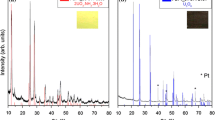Abstract
Purpose. The object of this study was to demonstrate the applicability of variable temperature X-ray powder diffractometry (XRD) to investigate solid-state reactions using aspartame as a model compound.
Methods. Aspartame exists as a hemihydrate (ASH) under ambient conditions and converts to aspartame anhydrate (ASA) at ∼130°C. ASA on further heating to ∼180°C undergoes decomposition (intramolecular cyclization) to form a diketopiperazine derivative (DKP). The dehydration as well as the decomposition kinetics were studied isothermally at several temperatures. The unique feature of this technique is that it permits simultaneous quantification of the reactant as well as the product.
Results. While the dehydration of ASH appeared to follow first-order kinetics, the cyclization of ASA was a nucleation controlled process. The rate constants were obtained at various temperatures, which permitted the calculation of the activation energies of dehydration and cyclization from the Arrhenius plots. The activation energy of dehydration was also calculated according to the method described by Ng (Aust. J. Chem., 28:1169-1178, 1975) and the two values were in good agreement.
Conclusions. The study demonstrates that XRD is an excellent complement to thermal analysis and provides direct information about the solid-states of various reaction phases.
Similar content being viewed by others
REFERENCES
J. L. Ford and P. Timmins. Pharmaceutical Thermal Analysis: Techniques and Applications, Ellis Harwood Limited, Chichester, UK, 1993.
D. Giron. Themal analysis and calorimetric methods in the characterization of polymorphs and solvates. Thermochim. Acta. 348:1-59 (1995).
J. Han and R. Suryanarayanan. Influence of environmental conditions on the kinetics and mechanism of dehydration of carbamazepine dihydrate. Pharm. Dev. Tech. 3:587-596 (1998).
S. Rastogi, M. Zakrzewski, and R. Suryanarayanan. Use of high temperature X-ray powder diffractometry (XRD) to investigate complex solid-state reactions. Pharm. Res. 14:S192 (1997).
J. Nishijo and F. Takenaka. Studies of the properties of the complex medicines. I. Differential thermogravimetric analysis of aminophylline. J. Pharm. Soc. Jap. 99:824-829 (1979).
J. Nishijo, H. Minamiguchi, and R. Moriya. Solid complex of theophylline with trimethylenediamine. J. Pharm. Soc. Jap. 100:157-161 (1979).
N. V. Phadnis and R. Suryanarayanan. Polymorphism in anhydrous theophylline—Implications on the dissolution rate of theophylline tablets. J. Pharm. Sci. 86:1256-1263 (1997).
H. Hashizume, S. Shimomura, H. Yamada, T. Fujita, and H. Nakazawa. An X-ray diffraction system with controlled relative humidity and temperature. Powder Diffr. 11:288-289 (1996).
S. S. Leung and D. J. W. Grant. Solid state stability studies of model dipeptides: aspartame and aspartylphenylalanine. J. Pharm. Sci. 86:64-71 (1997).
R. D. Skwierczynski., Disorder, molecular mobility, and solid-state kinetics: the two-environment model. J. Pharm. Sci. 88:1234-1236 (1999).
S. S. Leung, B. E. Padden, E. J. Munson, and D. J. W. Grant. Solid state characterization of two polymorphs of aspartame hemihydrate. J. Pharm. Sci. 87:501-507 (1998).
S. S. Leung, B. E. Padden, E. J. Munson, and D. J. W. Grant. Hydration and dehydration behavior of aspartame hemihydrate. J. Pharm. Sci. 87:508-513 (1998).
P. L. Klug and L. E. Alexander. X-ray Diffraction Procedures for Polycrystalline and Amorphous Materials, Wiley, New York, 1974.
S. K. Rastogi, Phase Transitions and Decomposition Reactions in Pharmaceutical Solids. Ph.D. Dissertation, University of Minnesota, Minneapolis, MN, 2000.
J. H. Sharp, G. W. Brindley, and B. N. N. Achar. Numerical data for some commonly used solid state reactions. J. Am. Ceram. Soc. 52:781-791 (1963).
R. Suryanarayanan, Determination of the relative amounts of anhydrous carbamazepine (C15H12N2O) and carbamazepine dihydrate (C15H12N2O · H2O) in a mixture by powder X-ray diffractometry. Pharm. Res. 6:1017-1024 (1989).
C. Ahlneck and G. Zografi. Molecular basis of moisture effects on the physical and chemical stability of drugs in the solid state. Int. J. Pharm. 62:87-95 (1990).
J. T. Carstensen. Stability of solids and solid dosage forms, J. Pharm. Sci. 63:1-14 (1974).
W. Ng. Thermal decomposition in the solid state. Aust. J. Chem. 28:1169-1178 (1975).
P. Jacobs and F. Tompkins. Classification and theory of solid reactions. In G. Garner (ed.), Chemistry of the Solid-State, Academic Press, New York, 1955 pp. 184-212.
P. K. Gallagher and D. W. Johnson, Jr. The effects of sample size and heating rate on the kinetics of the thermal decomposition of CaCO3. Thermochim. Acta 6:67-83 (1973).
C. O. Agbada and P. York. Dehydration of theophylline monohydrate powder—Effects of particle size and sample weight. Int. J. Pharm. 106:33-40 (1994).
Author information
Authors and Affiliations
Rights and permissions
About this article
Cite this article
Rastogi, S., Zakrzewski, M. & Suryanarayanan, R. Investigation of Solid-State Reactions Using Variable Temperature X-Ray Powder Diffractrometry. I. Aspartame Hemihydrate. Pharm Res 18, 267–273 (2001). https://doi.org/10.1023/A:1011086409967
Issue Date:
DOI: https://doi.org/10.1023/A:1011086409967




